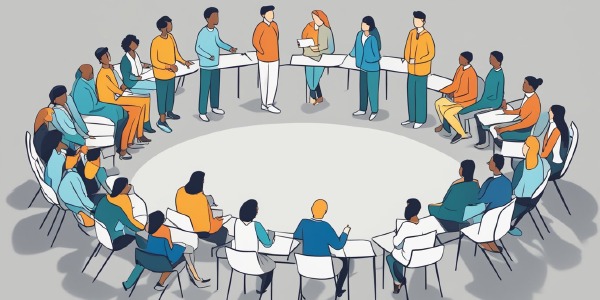Exploring World Cultures: Your Guide to Virtual Cultural Immersion
The world is a tapestry of distinct cultures, each with its own unique patterns of language, arts, traditions, and social norms.
By exploring the vast array of world cultures, you gain a deeper appreciation for the richness of human diversity.
Today’s technology offers an abundance of online resources that allow you to virtually journey across the globe, expanding your understanding and knowledge from the comfort of your own home.

As global citizens with a thirst for learning, you have the opportunity to connect and share with communities worldwide.
These connections foster a sense of global community and curiosity.
Leveraging online tools and educational platforms enables you to immerse yourself in the cultural intricacies of different societies, discover historical contexts, and engage with contemporary issues.
Such platforms can help scale the impact of education by making learning about world cultures more accessible and continuous.
Key Takeaways
- Online resources can significantly enhance your understanding of world cultures.
- These platforms help connect learners with global communities, fostering a sense of curiosity and wonder.
- By utilizing digital tools, you become part of a growing community of informed global citizens dedicated to continuous cultural education.
Understanding Cultural Diversity

Cultural diversity encompasses the variety of cultures that exist within society, reflecting the different ways of life, beliefs, and traditions of people around the world.
Recognizing this diversity and understanding its importance can lead to greater cultural awareness and sensitivity within increasingly globalized communities.
The Importance of Diversity in Society
Cultural diversity is the backbone of a vibrant society, bringing forth a rich tapestry of ideas, customs, and practices.
When you value diversity, you recognize that multiple cultural perspectives can contribute to problem-solving and innovation.
For instance:
- Creativity: Various cultures can inspire new art, literature, and ways of thinking.
- Economic Growth: Diverse teams in the workplace often lead to better performance and innovation, which can boost the economy.
Globalization and Its Impact on Cultures
Globalization refers to the interconnectedness of the world through trade, technology, travel, and communication.
Its influence on cultures is multifaceted:
- Cultural Exchange: You can experience foods, art, or festivals from different cultures without leaving your country, enriching your understanding of the world.
- Homogenization Concerns: There’s a risk that dominant cultures may overshadow local customs, which is why promoting cultural sensitivity is crucial in maintaining diversity.
Cultural Exploration Tools

To immerse in various cultures directly from your screen, a myriad of online tools stands at your disposition.
These resources enable you to explore the world’s diversity in an organized and engaging manner.
Online Encyclopedias and Databases
Encyclopedias and databases provide a wealth of knowledge on global cultures.
For instance, websites like Wikipedia offer in-depth articles on almost every aspect of world cultures, from history to cuisine.
Additionally, specialty databases such as Britannica or themed resources like National Geographic Education enrich your understanding of different regions with their well-researched content.
- Resource Examples:
- Wikipedia
- Britannica
Benefit: Access to a vast array of articles and resources with a simple search.
Interactive Geography Tools
Interactive tools like Google Earth and Google Maps are invaluable for geographical exploration.
You can virtually visit any corner of the globe, viewing mountains, cities, and landscapes from above or at street level.
Gapminder is an excellent resource to visualize sociodemographic statistics across countries, offering interactive charts and maps that bring data to life.
- Key Tools:
- Google Earth: Explore satellite imagery and 3D representations of terrain globally.
- Google Maps: Navigate and explore local cultures through street views and maps.
- Gapminder: Understand culture through data by exploring interactive graphs.
Purpose: Allows you to traverse global geographies and comprehend cultural contexts through visual data.
Cultural Exchange Platforms
Platforms like Touchable Earth promote cultural understanding by allowing users to learn about the daily lives of people around the world.
These platforms often have interactive elements such as videos, quizzes, and games to make the learning process engaging.
They serve as a bridge for cultural exchange and education, fostering global connections.
- Examples of Platforms:
- Touchable Earth: Delve into interactive content depicting life in various cultures.
Usage: Engage with multimedia resources for a vivid experience of global traditions and lifestyles.
Arts and Traditions Around the World

Discover the vibrant expressions of global cultures through their arts and traditions.
You’ll experience the world’s diverse heritage, from the melodic intricacies of world music and dance to the community spirit embodied in festivals and holidays, and the flavors that define various regional cuisines.
World Music and Dance
- World Music: Explore a variety of music styles, like the dynamic K-pop of South Korea, West Africa’s rhythmic Afrobeat, or the classical Ragas of India.
- Dance: Witness the precision of ballet, the storytelling of Chinese traditional dance, or the lively steps of the Brazilian Samba.
Festivals and Holidays
- Chinese New Year: Join in the celebrations with red decorations, dragon dances, and the giving of red envelopes.
- Carnival: Experience the color and excitement of Rio’s Carnival, showcasing samba music and parade floats.
Cuisine and Culinary Arts
- Cuisine: Taste the world by trying Japan’s umami-rich sushi, Mexico’s hearty tamales, or Italy’s al dente pasta.
- Features: Notice the importance of presentation in French gastronomy, and the use of spices in Indian dishes.
By engaging with these arts and traditions, you connect with people and their unique ways of life, gaining valuable insight into the world’s rich tapestry of cultures.
Language and Communication

Understanding languages and communication methods is crucial in connecting with diverse cultures.
Online resources have made it easier for you to learn languages and grasp the nuances of cross-cultural communication.
Language Learning Resources
Duolingo – This user-friendly platform offers you the opportunity to learn numerous languages through interactive exercises. You can track your progress and set daily goals to stay motivated.
Babbel – Babbel focuses on conversational skills and tailors your learning experience to your native language. It uses spaced repetition to help you remember what you learn.
Rosetta Stone – A pioneer in using immersive methods, Rosetta Stone helps you understand the language through context and images, rather than direct translation.
| Mango Languages | FlashAcademy | Memrise |
|---|---|---|
| Offers you practical, real-world conversations and cultural insights for a deeper understanding of the language. | You can learn through visual learning aids and customized review sessions for vocabulary retention. | Utilizes memory-enhancing techniques to help you remember new words and phrases effectively. |
Communication across Cultures
Coursera: Intercultural Communication and Conflict Resolution – This course equips you with the skills to navigate communication in different cultural contexts, emphasizing understanding and resolving conflicts that arise from cultural differences.
Tedx Talks on YouTube: Cultural Communication – TedX provides a plethora of accessible talks where you can hear stories and insights from communication experts around the world.
Podcasts – The World in Words, Linguistic Dissection, and A Way with Words – These podcasts offer you diverse perspectives on how language shapes thinking and communication in various cultures.
Each resource is a stepping stone to unlocking new interactions and stories from around the globe.
By embracing both language learning and cultural communication, you open doors to a more connected and understanding world.
Educator’s Corner

In your quest to provide a well-rounded education, you’ll find a wealth of online resources at your fingertips.
These tools are designed to support you in delivering engaging lessons that open students’ eyes to the diverse cultures of the world.
Lesson Plans and Teaching Materials
- Comprehensive Curriculum: Websites like Share My Lesson and Edutopia offer a variety of culturally diverse lesson plans tailored for different age groups and subjects. You can find ready-to-use materials that bring global awareness into your classroom.
- Customizable Content: Many platforms allow you to filter resources by grade, subject, or cultural focus, ensuring that you can customize lessons to meet your curriculum goals.
- Start with a template: Templates provide a scaffold for integrating cultural topics.
- Incorporate multimedia: Use videos and interactive elements to enhance the learning experience.
Global Learning for Students
- Interactive Experiences: Platforms like Google Arts & Culture provide students with virtual tours of museums and historical sites. This helps bridge the gap between the classroom and far-off cultures.
- Language Learning: Encourage your students to use apps like Duolingo to learn new languages. This fosters better understanding and appreciation of other cultures.
- Encourage group projects: Group work can encourage students to explore cultural topics collaboratively.
- Emphasize critical thinking: Discussion prompts and reflection questions can deepen students' global perspective.
Visual Learning

Visual resources are a wonderful way for you to immerse yourself in world cultures. They can often relay complex information quickly and engagingly.
Photography and Videos
Photographs and videos are powerful media that bring stories to life. National Geographic is renowned for its stunning photography that captures the essence of diverse cultures. By browsing their collection, you can view high-quality photos and videos that tell compelling stories of people from all corners of the globe.
- Watch documentary videos to see cultural practices in motion.
- Explore photo essays to witness daily life and special events.
- Use 360-degree videos for an immersive experience.
Infographics and Graphic Features
Infographics and graphic features distill cultural details into visual formats that are easy for you to understand. These graphics often combine data and design to educate about different cultures in a visually appealing way.
- Discover infographics that compare cultural statistics, like national holidays or food consumption.
- Visualize complex systems, such as language families or historical timelines, through well-designed graphic features.
History and Geography

When exploring world cultures, a solid grasp of history and geography is essential. These subjects provide the backdrop that shapes various countries and cultures across continents such as Africa, Asia, and Europe.
Understanding Historical Context
To truly appreciate the tapestry of global cultures, you must understand the historical context that has shaped them. Start with timelines of significant events that have influenced societies, from ancient civilizations to modern nations.
- Africa: Examine the rise and fall of empires like Mali and Songhai, and the impact of colonialism on the continent’s various cultures.
- Asia: Trace the historical journey of the Silk Road and its effect on trade and cultural exchange among Asian countries.
- Europe: Investigate the Renaissance period and how it spurred a cultural awakening across European societies.
Geographical Exploration and Discovery
A country’s geography can tell you a lot about its culture, from dietary habits to traditional dress. Use maps and satellite imagery to explore diverse landscapes and understand how they’ve contributed to the development of distinct cultural identities.
- Africa: Explore the Sahara Desert and Nile River to see how these geographical features have been central to both historical development and current issues.
- Asia: Look at the vast range of climates, from the tundra of Siberia to the tropical forests of Southeast Asia, and how these have influenced local cultures.
- Europe: Navigate through the Alps and the Mediterranean and consider their role in shaping the interactions between different European cultures.
Cultural Insights

In this section, you will uncover the heart of various cultures through personal experiences and an examination of different cultural norms.
Personal Stories and Experiences
Learning about another culture is enriched when you hear directly from the people who live it. Websites like Humans of New York offer a window into the lives of individuals from around the globe, letting you explore a myriad of personal stories. Through these narratives, you gain insights into beliefs, customs, and the texture of everyday life. Reading first-hand accounts can evoke empathy and enhance your understanding of the society in question.
- Examples:
- Blogs or social media accounts where individuals discuss their daily lives.
- Audio or video interviews with people from different backgrounds sharing their perspectives.
Cultural Norms and Societal Structures
Every community has its unique way of life which guides how its members interact with one another. For in-depth knowledge, you might turn to resources that dissect cultural norms and societal structures. Scholarly articles, cultural databases like Everyculture.com, and virtual museum exhibitions can provide systematic overviews of social hierarchies, religious practices, and community rituals.
- Elements to Look For:
- Etiquette and manners in various social situations.
- Roles and expectations within family and community units.
- Influence of religion and other belief systems on daily life.
Contemporary Issues in World Cultures
As you explore world cultures, you’ll find that current events are shaping them in real time. These shifts include the way societies respond to environmental issues, economic changes, and ideological movements.

Climate Change and Environmental Challenges
Global warming and environmental degradation are urgent issues across different cultures. Climate change, for example, affects weather patterns, leading to extreme weather events that influence agriculture, water supplies, and living conditions.
- Challenges: Mitigating carbon emissions, transitioning to renewable energy, and preserving biodiversity.
- Opportunities: Advancement in green technologies and international cooperation on environmental policies.
Economic and Business Trends
The global economy is interconnected, with each culture contributing to a complex web of trade and commerce. Recent trends reflect a shift towards digitalization and the gig economy.
- Challenges: Income inequality, job displacement due to automation, and the need for sustainable economic growth.
- Opportunities: New markets in technology and services, and the potential for entrepreneurship to empower individuals.
Religious and Political Movements
Religious and political beliefs have a profound impact on cultures, often driving social change or conflict. Current events frequently stem from, or result in, shifts in these movements.
- Challenges: Balancing freedom of expression with preventing extremism, and navigating political polarization.
- Opportunities: Increased dialogue among diverse groups and the potential for political movements to enact positive social change.
Connecting and Sharing with Global Communities

In today’s interconnected world, you have numerous opportunities to engage with global communities online. This engagement fosters connections and cultural exchange, enhancing your global understanding through cooperation and shared experiences.
Online Forums and Discussion Groups
Online forums and discussion groups are virtual spaces where you can connect with individuals from around the world. Platforms like Reddit and Quora have dedicated threads for cultural exchange, where you can:
- Ask questions about different cultures
- Share your own experiences and learnings
- Participate in topical discussions to gain diverse perspectives
Travel and Tourism Opportunities
Travel forums such as TripAdvisor and Lonely Planet’s Thorn Tree provide a wealth of information for tourism, but they also facilitate community interaction. By exploring these platforms, you can:
- Get firsthand travel advice and connect with locals or fellow travelers
- Discover cultural experiences and community-led tourism initiatives
- Join groups or events that further promote international collaborations
International Collaborations
Participating in international collaborations can greatly expand your cultural insight. You can contribute to global projects through platforms like Global Voices or UN Online Volunteering, where you will:
- Work alongside people from various cultures on cooperative projects
- Engage in virtual exchanges that support causes and foster community ties
- Utilize these experiences to build long-lasting international networks
Technologies Accelerating Cultural Connection

In today’s interconnected world, innovative technologies play a crucial role in enhancing your ability to engage with and understand diverse cultures. From transportation that bridges physical distances to digital tools that facilitate communication and learning, these advancements are pivotal in fostering global cooperation and education.
Transportation Advancements
Transportation technologies have dramatically reduced travel times, making it easier for you to explore new cultures firsthand. For instance:
- High-speed rail systems, such as Japan’s Shinkansen, can whisk you to different cultural regions in hours rather than days.
- Airlines utilize advanced aircraft, like the Boeing 787 Dreamliner, that offer fuel efficiency and longer ranges. This opens up more direct routes to previously less-accessible areas.
Communication Technology
The evolution of communication tools has transformed how you connect with people globally. Specifically:
- Social media platforms, like Facebook and Instagram, enable you to share and experience cultural moments instantly with a global audience.
- Translation apps, such as Google Translate, break down language barriers, allowing for seamless interaction across different linguistic backgrounds.
Learning and Education Technology
Educational platforms have made it easier to acquire cultural knowledge. Here’s how:
- Online courses provide structured learning experiences about world cultures, often for free or at a low cost.
- The Explorer Classroom initiative connects you with National Geographic Explorers in live video events. Interactive learning about cultures happens in real-time.
By leveraging these technologies, you’re equipped to gain deeper insights and form meaningful connections with cultures around the world.
Scaling Impact through Education

In today’s interconnected world, expanding your understanding of global cultures can be transformative, not only for personal growth but also to foster wider social impact through education. The key to broader cultural appreciation lies in the accessibility and scalability of educational resources and collaborative efforts.
Creation of Scalable Cultural Learning Resources
To ensure that cultural learning can reach a wide audience, resources need to be both high-quality and scalable.
- Multimedia Lessons: Engaging visual and auditory content makes learning about cultures more accessible for people with different learning styles. Each lesson can be a mix of text, images, and videos.
- Interactive Modules: You can participate in quizzes and games to test your knowledge, which can be adjusted to serve large numbers of users simultaneously.
- Downloadable Content: Providing resources like eBooks and printable materials ensures that education can continue offline.
Creating these resources requires expertise in cultural studies, pedagogy, and technology but the potential to reach millions makes it worth the effort.
Networks and Partnerships for Education
Collaboration amplifies the impact of educational endeavors. Here’s how strategic networks and partnerships work to scale up cultural education:
- Cross-border Collaborations: Partnering with educational institutions around the world brings diverse perspectives into your learning journey.
- Community Engagements: Local communities contribute to the authenticity of the content, offering firsthand insights and stories.
- Corporate Partnerships: Businesses can offer funding and technology, improving the reach and quality of cultural education.
These networks and partnerships pave the way for new opportunities, enabling lessons on world cultures to resonate on a global scale. SUPPORT service provides a network of educators and resources, making scaling educational initiatives more manageable and effective.
Resources for Continuous Learning

Enhancing your understanding of world cultures isn’t just educational; it’s an ongoing adventure. These resources are designed to provide you with continuous opportunities to expand your knowledge and engage with diverse arts and educational experiences.
Online Courses and Workshops
Coursera and edX offer a broad selection of online courses in global studies and cultural diversity.
These platforms allow you to learn about different societies from renowned universities like Harvard and Stanford.
Udemy provides workshops that focus on practical skills in cultural arts, often taught by native experts.
- Examples:
- Coursera: “Indigenous Peoples’ Rights” by the University of Alberta
- edX: “Global China: From the Mongols to the Ming” by HarvardX
- Udemy: “Japanese Calligraphy for Beginners”
Cultural Competency Certifications
Achieving a cultural competency certification can be a formidable addition to your professional skill set.
Organizations such as the Cross-Cultural Health Care Program (CCHCP) and Cultural Intelligence Center offer certifications that can validate your expertise in navigating and appreciating multicultural environments.
- Key Certifications:
- CCHCP’s “Bridging the Gap” Medical Interpreter Training
- Cultural Intelligence Center’s “Cultural Intelligence (CQ) Certification”
Field Trip and Immersion Experiences
While digital learning is invaluable, there’s no substitute for real-world experiences.
You can find opportunities through study abroad programs, cultural exchanges, or local field trips that promote immersive learning.
- Field Trip Suggestions:
- Visit the British Museum for a guided cultural heritage tour.
- Join a cultural exchange program through organizations like AFS Intercultural Programs.
- Look for immersion experiences offered by universities during summer sessions.
Final Thoughts

As you navigate through the sea of online resources, always keep in mind that immersing yourself in world cultures is a valuable part of your education.
These virtual explorations can foster a deep appreciation for the diversity that shapes our global community.
- Culture: By engaging with a multitude of cultures, you not only gain knowledge but also become a citizen of the world.
- Education: Remember, every article read and every virtual tour taken expands your horizons.
- Appreciation: Absorbing traditions and customs different from your own deepens your cultural sensitivity.
- Inspiration: Let the stories of people and their customs inspire your daily life and possibly the path you choose to take.
- Growth: With every discovery, you grow a little more, developing perspectives that were once foreign to you.
- Empathy: Understanding and empathy are the natural outcomes of seeing the world through the eyes of others.
Let these resources be the bridge that connects you to the vast tapestry of human experience.
Embrace the opportunity for growth and the joy of learning that comes from engaging with cultures around the globe.




